ALBUQUERQUE, N.M. — Competing in an international pool of universities, corporations and government labs, inventions from Sandia National Laboratories captured seven R&D 100 Awards (one in conjunction with the National Renewable Energy Laboratory) this year, as well as two special awards for green technology and corporate responsibility.
Independent panels of judges selected projects to represent the year’s 100 most outstanding advances in applied technologies. The awards focused on practical impact rather than pure research, and recognized entrants for their products’ designs, development, testing and production.
The criterion for winning has been “demonstrable technological significance compared with competing products and technologies,” and emphasizes properties such as smaller size, faster speed, greater efficiency and higher environmental consciousness.

Secure-Firmware Over-the-Air, developed at Sandia National Laboratories, can allow car manufacturers to remotely manage firmware updates and provides enhanced security. (Photo courtesy of Sandia National Laboratories) Click on the thumbnail for a high-resolution image.
The R&D 100 Awards began in 1963. Since 1976, Sandia has earned 139 awards, including this year’s winners.
The following is a list of Sandia’s winning projects.
Secure-Firmware Over-the-Air
The embedded software known as firmware requires frequent updates in most modern cars. But when these updates occur remotely over the airwaves, the update process is vulnerable to cyberattacks that can compromise critical functions like air bag response, steering, acceleration and braking. S-FOTA protection can be installed as a firmware plug-in in each car at its manufacturing plant and remotely managed by the manufacturer, without ever inconveniencing vehicle owners. S-FOTA provides the convenience of a single application interface as well as authenticity assurance, with enhanced security from mathematically quantifiable integrity checks.
Slycat
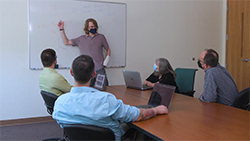
Members of the research team working on Slycat at Sandia National Laboratories. (Photo courtesy of Sandia National Laboratories) Click on the thumbnail for a high-resolution image.
Computational modeling frequently generates collections of runs known as ensembles. Ensemble sizes can exceed 10,000 runs, each with hundreds of changing variables, plus multimedia outputs. Slycat makes sense of ensemble data by integrating data management, scalable analysis, abstract visual representations and remote interaction through a web-based interface that is designed for access-controlled collaboration between authenticated project members.
WEC-Sim (Submitted by the National Renewable Energy Laboratory)
Wave Energy Converter Simulator (WEC-Sim) is widely used by academia and industry to better understand how devices convert the motion of waves into usable energy and fare in the open sea.
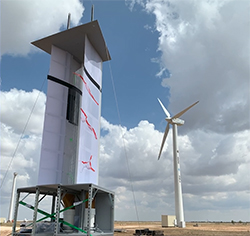
Sandia National Laboratories co-developed a stationary wind harvester with no external moving parts. (Photo courtesy of Sandia National Laboratories) Click on the thumbnail for a high-resolution image.
This advance can help replace physical testing with computer modeling and is the first open-source software tool allowing developers to numerically model wave-energy converter dynamics and performance. The multi-year collaborative effort included a team of researchers from Sandia and the National Renewable Energy Laboratory.
AeroMINE
Stationary wind harvesters can provide distributed electricity generation with no external moving parts. Co-developed by Sandia researchers with Westergaard Solutions Inc. and Texas Tech University, they can complement rooftop solar set-ups and provide affordable, reliable power to warehouses, box stores, commercial buildings, military bases and remote locations, reducing greenhouse gas emissions from conventional sources.
Distributed wind energy has the potential to significantly increase world-wide green energy production and allow microgrids to supplement the electricity grids in many regions.
Potent and Effective Synthetic SARS-CoV-2 Neutralizing Nanobodies
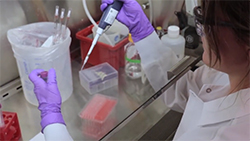
Researchers at Sandia National Laboratories have assembled extremely potent next-generation anti-COVID-19 neutralizing antibodies. (Photo courtesy of Sandia National Laboratories) Click on the thumbnail for a high-resolution image.
Using a library of variable antibody fragments called nanobodies, Sandia researchers have assembled extremely potent next-generation anti-COVID-19 neutralizing antibodies. The unique features of nanobodies offer easier manufacturability, increased versatility, smaller size and the ability to bind to more than one target site to increase potency and resistance to viral mutants. Researchers have shown they can produce a nanobody-based countermeasure within 90 days, once a virus’ genetic code has been identified. The method has not yet been tested on humans. The researchers have filed for a patent on aspects of their work and are actively seeking commercial partners to help identify and engineer next-generation antibodies.
RAPTR N95
A reusable and rapidly producible N95 respirator for medical applications developed at Sandia can be completely disassembled for sterilization, decontamination and component replacement.
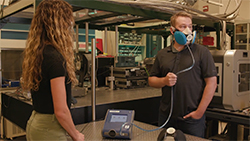
Sandia National Laboratories developed a reusable and rapidly producible N95 respirator for medical applications in the RAPTR N95 project. (Photo courtesy of Sandia National Laboratories) Click on the thumbnail for a high-resolution image.
A swappable passive resonator transmits voice or can be used for fit certification. Air is filtered during inhalation/exhalation. A wide range of filter media, held in a protective structure, can be used to help alleviate supply chain issues. The researchers have filed a patent for the design of the RAPTR and are open to licensing the design.
Quantum Scientific Computing Open User Testbed
QSCOUT provides scientists free and complete access to the only open quantum computing testbed in the world based on trapped ions. It gives the scientific community a new level of programming control and execution for improving quantum computer science.
These types of controls give researchers the ability to study and answer the major open questions in quantum computing, including understanding and mitigating sources of noise, learning how to characterize and validate quantum operations and developing and optimizing quantum algorithms for scientific applications.
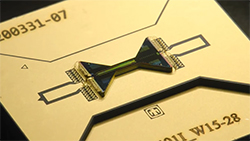
QSCOUT at Sandia National Laboratories provides scientists free and complete access to the only open quantum computing testbed in the world based on trapped ions. (Photo courtesy of Sandia National Laboratories) Click on the thumbnail for a high-resolution image.
In short, QSCOUT is a quantum computer for scientists, made by scientists, to advance quantum computing science.
In addition, Sandia researchers were awarded:
- A GOLD (first place) Special Recognition in Green Technology award for Environmentally Benign Extraction of Critical Metals using Supercritical CO2-Based Solvent: Sandia researchers were recognized for a method that uses environmentally harmless citric acid in tandem with carbon dioxide to detoxify coal tailings by extracting critically needed rare elements and more harmful components at the same time. The extraction improves the environment instead of destroying it as conventional mining may do.
- A SILVER (second place) Corporate Social Responsibility award for RAPTR N95
Portions of this research were funded by Laboratory Directed Research and Development.
Sandia National Laboratories is a multimission laboratory operated by National Technology and Engineering Solutions of Sandia LLC, a wholly owned subsidiary of Honeywell International Inc., for the U.S. Department of Energy’s National Nuclear Security Administration. Sandia Labs has major research and development responsibilities in nuclear deterrence, global security, defense, energy technologies and economic competitiveness, with main facilities in Albuquerque, New Mexico, and Livermore, California.
Sandia news media contact: Neal Singer, nsinger@sandia.gov, 505-977-7255